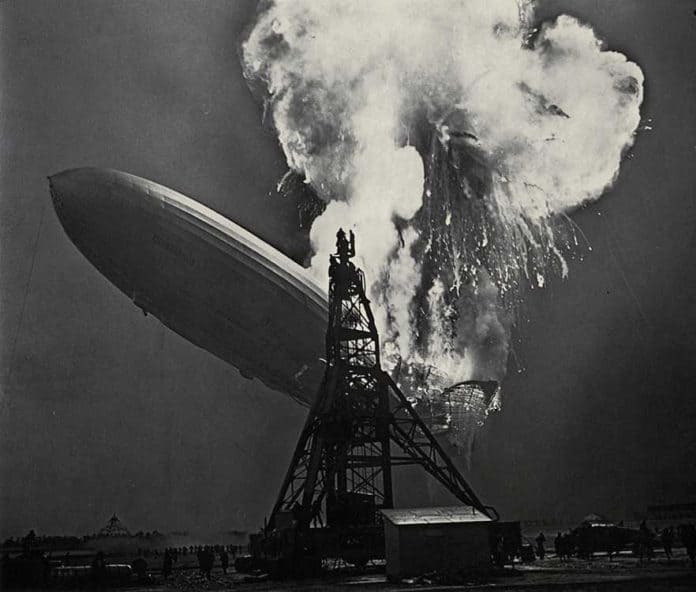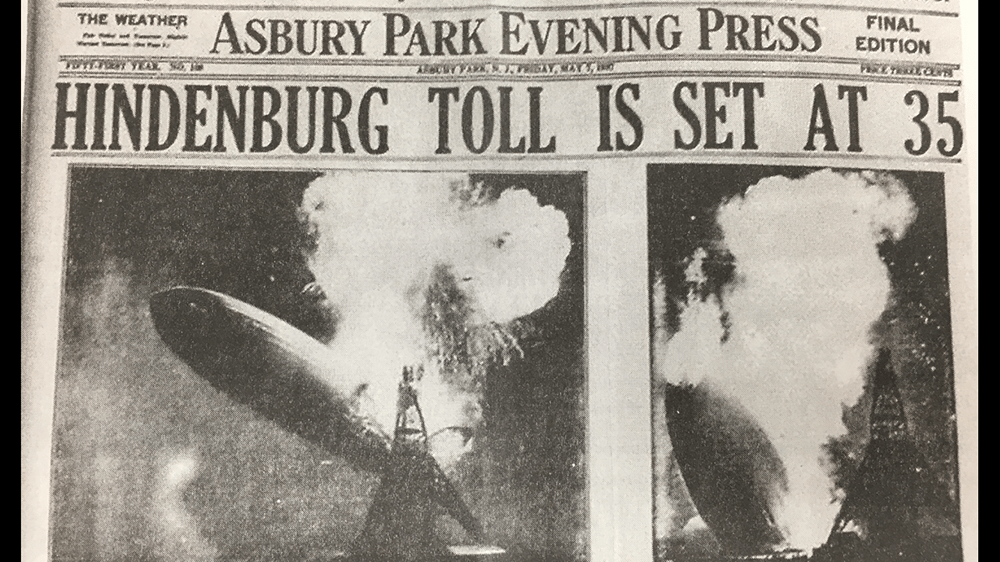
LAKEHURST – As the 86th anniversary of the Hindenburg disaster approaches, a member of the Navy Lakehurst Historical Society brought to light a forgotten figure of the tragic saga.
Jim Larsen, a resident of Leisure Village West, Manchester, noted that everyone remembers or is taught about the events of December 7, 1941 – the attack on Pearl Harbor – and September 11, 2001, when terrorists attacked America.
Larsen is a survivor of the latter, having been in Tower 1 of the World Trade Center. “I was in the 65th Floor on the west side.” He noted that few remember the individuals who were caught up in such events and for that reason, he felt it was important to share the story of Allen Hagaman.
“Most people today don’t even know he existed,” Larsen told The Manchester Times.
Hagaman was born in 1885 and was 52 in 1937, Larsen said. He was married and had been a resident of Lakehurst from about 1910. His home was located on Cedar Street and he had lost his business on Union Street, the town’s main street. During the 1930s, he and several of his relatives and friends had turned to the nearby U.S. Naval Air Station Lakehurst for employment.
On May 6, 1937, he was paid a dollar and a ham sandwich to be among the landing line crew to secure the Hindenburg.
The morning of May 6 had dawned bleak and stormy; not much of a day to spend at Naval Air Station Lakehurst awaiting the Hindenburg. For Hagaman however, “it at least promised to be profitable, if you consider a one dollar a day’s salary, issued with a wooden nickel to turn in for a ham sandwich, profitable,” Larsen said.
He knew a dollar in those rough financial times could buy quite a bit, and since he had no other promise of income that day, he decided to help haul in a big balloon and get paid for it. Following his quick meal, he left for the base and met up with three of his buddies and workmates with whom he’d assist the landing line crew in moving the Hindenburg to a nose-docking of the craft.
His team was supposed to secure the lower tail fin to the stern mooring car, thus anchoring the tail of the craft. However, by 5:30 p.m., there was no sign of the Hindenburg. It was raining intermittently, and the ground crew, 240 strong, were getting wet in the landing field waiting for the airship.
Upon arrival over Lakehurst, the ship’s commander, Captain Max Pruss, was told he would not be cleared to land due to thunderstorms in the area. He was advised of a possible break in the weather, and it looked like there might be a landing “window” at about 7 p.m., four hours later. Pruss then decided to take his airship south to Cape May, turn and head north, giving his passengers an aerial tour of the beautiful Jersey Shore.
Around 7 p.m. the Hindenburg was sighted approaching the landing zone from the southwest. It slowed to a hover at 200 feet over the landing line crew, with its back engines turning just enough to keep it stationary against the swirling winds, Larsen said.
Hagaman and his group got to work moving the stern mooring car to ensure it would be ready to accept the airship’s tail when it was drawn in. At about 7:20 p.m., mooring lines were dropped from the nose of the ship, and the landing line crew began walking the ship to the mooring mast, a mobile tower to which the nose of the airship would be affixed, rendering it secure.
Four minutes after the landing lines touched the ground, the Hindenburg suddenly burst into flames at the top of the fuselage just forward of the tail fin.

The reports of the disaster announced that the fatalities numbered 36: 22 Hindenburg crew members, 13 passengers, and one ground-based linesman, Allen Hagaman. His body, pinned under the wreckage and severely burned, was later identified by his comrades and other members of the ground crew.
After the sensationalism of the crash wore off Hagaman’s name soon slipped into obscurity, suffering much of the same fate as so many others lost in tragic circumstances over the years.
Due to the efforts of historians, history buffs and organizations like the Navy Lakehurst Historical Society, Hagaman’s memory has not been forgotten.
He is fondly remembered by his descendants who have visited the memorial site and given information to the NLHS. This information is included in the narration made to visitors who come out to the museum in Hanger One that once housed the Hindenburg and the site outside where the tragedy took place.
Larsen noted that the NLHS will once again be coordinating an anniversary service for the Hindenburg tragedy on May 6 at that site. The organization was recently awarded $850 as part of an Ocean County Tourism grant for their marketing program.
The group encourages the public to visit their museum and take a tour of this historical site and walk back through time. Those who wish to take a tour must pre-register by calling 732- 600-8055 or e-mail tours@nlhs.com






